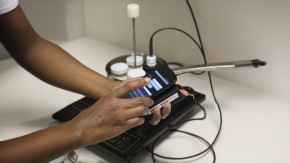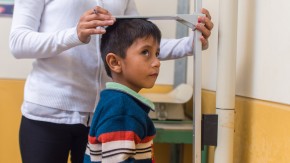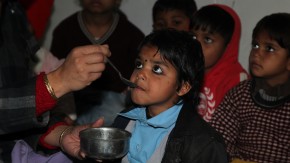Innovation: How a 50-Year-Old Drop of Blood Helps Solve an Urgent Global Health Challenge
- Trevor Mundel, Dec 7, 2017

If you're under the age of 50 and were born in a developed country, chances are that when you were just minutes old a nurse pricked your heel, took a few drops of blood, and sent it off to be tested for an array of congenital diseases. Teams at the University of California-San Francisco, Ottawa Hospital Research Institute, and the University of Iowa are now looking at hundreds of thousands of these heel spots with fresh eyes to solve a very different problem - premature birth in developing countries.
In high-income countries, babies born preterm (before 37 weeks in the womb) are at increased risk for complications, but many of these complications can be treated effectively with readily available tools, including ventilators to help preterm newborns breathe, IV lines to supply nutrition and antibiotics to treat sepsis.
But in low-income countries, it's a lot harder to manage complications like asphyxia and infection. And that's why preterm birth is the leading cause of death among children globally.
With support from the Gates Foundation and other partners, researchers are studying how to prevent preterm birth or deal with its consequences in a way that works in low-income settings, but there's a problem: as things stand, it's hard to test these interventions - or think about where, when, and how to use them - because we have only a vague idea how many babies are born preterm or how preterm they are.
A woman whose first visit to a clinic is to deliver her baby, or whose clinic doesn't have an ultrasound machine, may not remember the month of her last period, in which case doctors and nurses must make their best guess about the baby's gestational age. If newborns are smaller than usual, one might assume they are preterm - but they could just as easily be full-term babies small for their gestational age. In either case, babies will need different types of care, so being able to tell preterm newborns from full-term newborns is vital if we want to bring down the number of neonatal deaths in resource-constrained settings.
And being able to distinguish between preterms and full-terms will also help researchers develop better methods to prevent preterm birth. If we can measure accurately how prevalent prematurity is, and how those prevalence rates are changing, we'll be able to pinpoint the lifesaving impact of various interventions.
The teams in California, Ottawa, and Iowa (led by Drs. Laura Jelliffe-Pawlowski, Kumanan Wilson, and Kelli Ryckman, respectively) may have cracked the case - and it goes back to those hundreds of thousands of heel pricks from babies born in Canada and the U.S.
When babies' blood is tested for disease, the lab makes adjustments based on the baby's gestational age, which is usually available in wealthy nations either from ultrasounds or from an accurate LMP (last menstrual period) record. What might be a normal level of a certain metabolite in a full-term baby's blood will not be normal in a preterm baby's blood.
What our grantees are doing is reversing the process. Rather than using gestational age to figure out how much of a given metabolite they should expect to find, they're using metabolites to develop an accurate estimate of gestational age. By measuring all the metabolites that doctors measure (about 50 in all), the teams have narrowed the predictive accuracy of the test to about one week, more or less, of the correct age. Now they're hoping to develop a test that can achieve the same level of accuracy by measuring just one or two highly indicative metabolites.
One metabolite in particular, fetal hemoglobin, has proven especially useful. Hemoglobin is the metabolite that carries oxygen and offloads carbon dioxide. Because there isn't as much oxygen inside the womb as there is outside, a fetus needs a different kind of hemoglobin than an adult. Starting mid-gestation and continuing over the course of several weeks, fetal hemoglobin is slowly replaced by adult hemoglobin, until at six months after full-term birth, there's little fetal hemoglobin left.
This means that Drs. Jelliffe-Pawlowski, Wilson, and Rychman may be able to look at the ratio of fetal hemoglobin to adult hemoglobin - a single metabolite - and trace the timeline back until they know, to within two or three weeks, when a baby was conceived. Furthermore, unlike the other metabolites, which need to be collected within a day or two of birth, fetal hemoglobin may remain a valid measure for months.
Once this work was done with the samples from the United States and Canada, the researchers had to determine whether the same technique would work in low-income countries. They started working with data from Africa and South and Southeast Asia, and the results have been extremely encouraging. For one thing, they've found that blood from the umbilical cord gives results about as accurate as from a heel prick, which is great: it's much easier to collect blood from something you're already discarding than to ask a new mother for permission to make her newborn bleed. More importantly, preliminary data suggests that the technique can be effectively replicated in developing countries.
We have a long way to go. If the new studies show that the new technique gives a good estimate of gestational age in low-income countries, we'll have to gather the blood and analyze the data - and even at that point, we'll still be at the end of the beginning because knowing how many babies are born prematurely (and where) is just the first step in reducing that number.
But I'm excited by the work of Drs. Jelliffe-Pawlowski, Wilson, and Ryckman and their teams. They took a procedure that we've been using in wealthy countries for decades, looked at it anew, retrofitted it, and found an innovative solution for a problem no one had even imagined when the process was invented.



